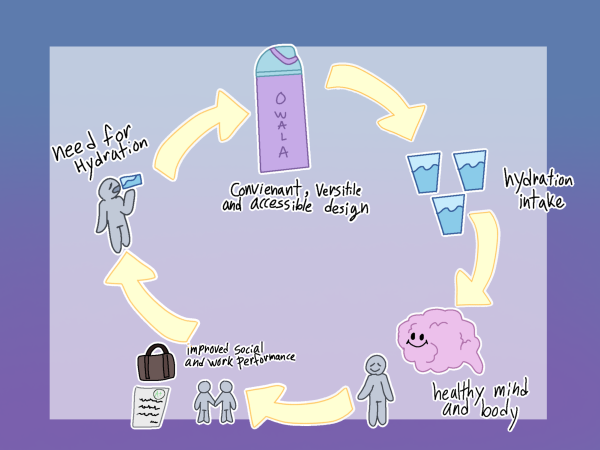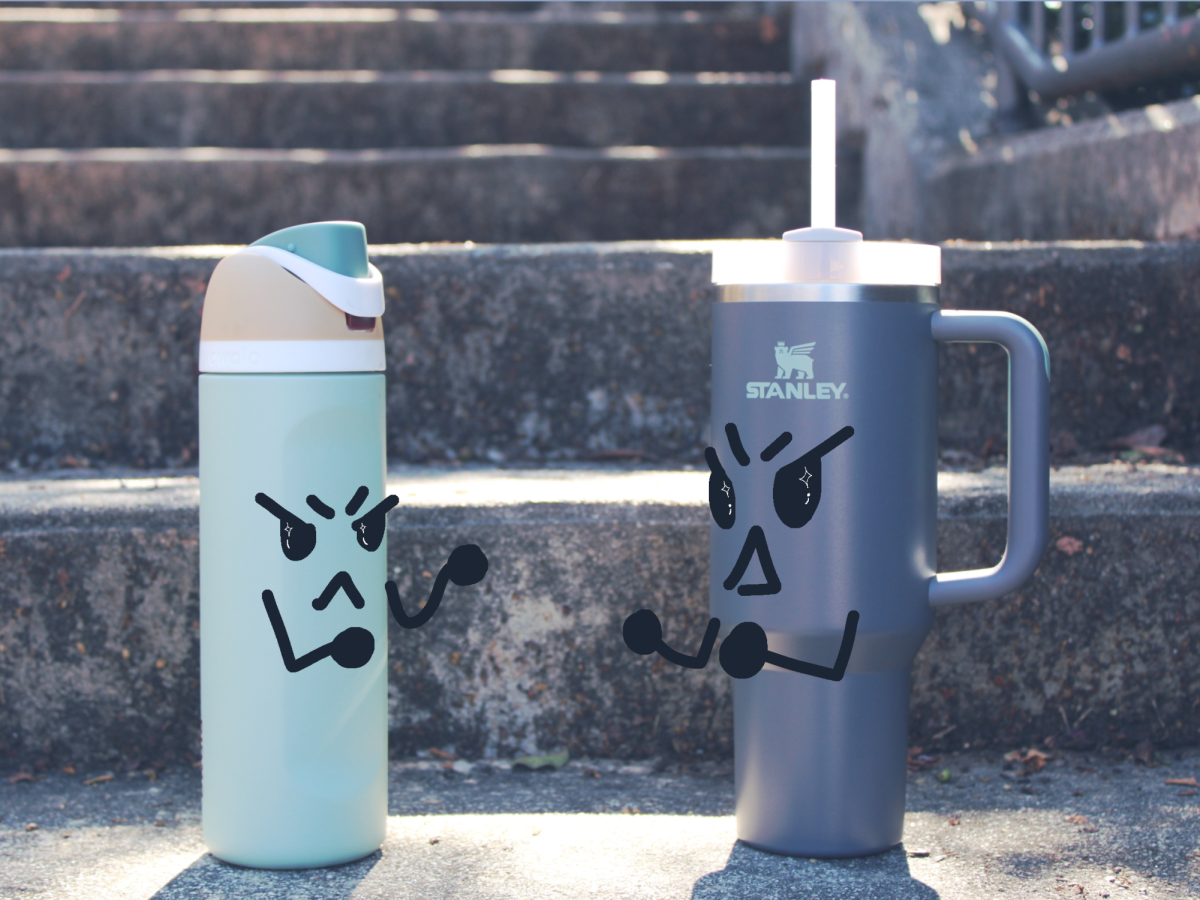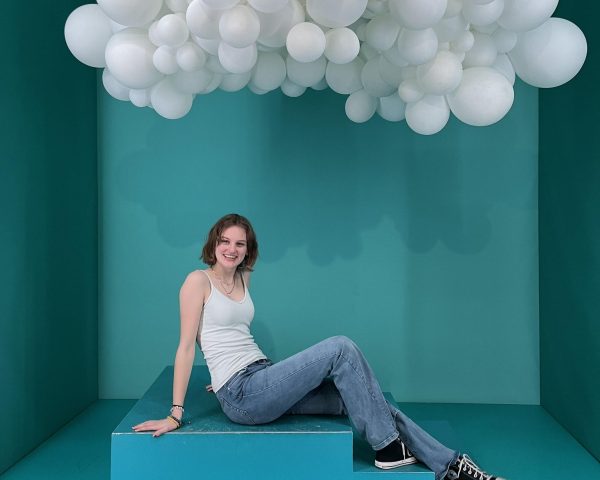Reusable water bottles remain eco-friendly staples for hydration in an age of global warming, mass pollution and biodiversity loss. Among the numerous options of turtle-saving bottles, the brands Owala and Stanley stand out. Each bottle offers unique features and designs tailored to different lifestyles and preferences. Owalas, however, reign supreme by providing effective hydration in both form and function.
Launching in March 2020, Owalas quickly rose to the top of the U.S. water bottle market. The notorious FreeSip bottle received close to 50,000 five-star ratings on Amazon, while TikTok users viewed the hashtag #owala over 272 million times. Owala offers a variety of colors depending on the specific product, releasing limited editions called Color Drops every month; the new patterns and colors commonly tie to the current season.
Among its various attractive qualities, Owala’s ability to provide reliable and handy hydration may take the cake. The versatile design of the bottle allows for water access with minimal effort and maximum convenience. Both the use and maintenance of Owalas deliver an enjoyable experience.
“As someone who isn’t the best when it comes to staying hydrated, having an easily functional bottle makes it just that much easier to take that sip and hydrate. They are very convenient due to their practicality. They’re very easy to drink from, hold, take places, and clean,” magnet junior Grace Amah said.
Water’s role in biological survival remains unquestioned. A concerning and common phenomenon, dehydration, causes symptoms such as a dry mouth, extreme thirst, less frequent/dark-colored urination, fatigue, confusion and dizziness. For the body to function, it must receive the proper care. There lies the appeal of the Owala: the transportable size, the convenience of a straw-lip combo and its low maintenance provide simple but effective hydration. Humans crave convenience, so a simple and enjoyable experience from water bottles encourages a person to stay hydrated. This benefits not only the physical health of the user — regulation of body temperatures, preventing infection, aiding organs in functioning — but the mental health as well — improved sleep quality, cognitive function and mood. These symptoms directly impact the productivity and quality of daily life, which ripple effects onto work, school, mental health, social lives and everyday tasks.

Those in favor of Stanleys, a formidable opponent in the water bottle market, prefer the classic soccer mom cup due to its endurance and versatile functions. Stanley advertises a built-for-life quality of products, able to endure polar expeditions, wildfires, desert adventures and survival scenarios. The extreme-situation tolerance combined with a multitude of design options and personalized features, including over 100 colors in the Quencher H2.0 Flowstate Tumbler alone and a popular customization option for a variety of bottles. This provides Stanleys an edge over Owalas in the eyes of its loyal users.
“The Stanley design is great when [planning] either a night out, going to a ballgame, or attending school. In addition, the numerous color options allow for someone’s individuality to shine through. [This makes] a cup not just about the beverage inside,” junior Serenity Norris said.
Similar to Stanleys, however, Owalas provide durable and personalized options ranging from Kids’ Tumblers to the classic FreeSip. Owala designs aim to provide a helping hand, not a survival guide. While useful in the zombie apocalypse, a water bottle’s survival skills ultimately hold less importance than its day-to-day practicality. Owala’s designs tend to spill less than Stanely’s. The popular FreeSip bottle promises a completely leakproof product. The 40 oz Tumbler slows down water spillage with a closed straw opening and splash-resistant lid, also providing a 2-in-1 option to sip with a straw or gulp from the lid. The Kids’ Tumblers feature spill-resistant lids and straws designed to prevent and decelerate water leaks.
A clumsy-friendly composition pairs with a multitude of size options. This sleek design enables convenient storage in the side pocket of a backpack or a young kid’s grip. Additionally, the openings provide multiple methods of consumption, providing for users in need of a quaint sip or a thirsty chug. In these ways, Owala represents a versatile and reliable hydration option for both on-the-go and leisurely usage.
“This water bottle is very convenient for my different lifestyles. As a student, I prefer the sip option. It’s less noisy in class. However, as an athlete, I definitely prefer the chug option,” Amah said.
Stanleys, while attractive to a plethora of users, remain limited in functionality. Spill-proof promises instead allow for plentiful leakage if knocked, opened or dropped. Unlike Owalas, a majority of Stanleys feature only one method of drinking. Additionally, when comparing the two highly recognizable designs — the Owala FreeSip and Stanley Thirst Quencher H2.O — the FreeSip fits with ease into bag side pockets, car door pockets and kitchen cabinets in contrast to Stanley’s comparatively bulky build. Other designs of both brands’ bottles exist with their respective benefits, but the best-seller experiences ultimately provide features tipping in Owala’s favor.
The power-couple-esque combination of diverse design options paired with practicality perfectly defines why Owalas leap into the hands of users worldwide. While respectable in every way, Stanleys can not provide the accessible and enjoyable experience of an Owala. Ultimately, the choice between the two competing water bottles lies in the consumer’s hands; plentiful hydration and a worthwhile purchase drive the choice between the brands. For the research-minded water bottle gurus, Owalas bring a refreshing twist into the world of hydration and health.












